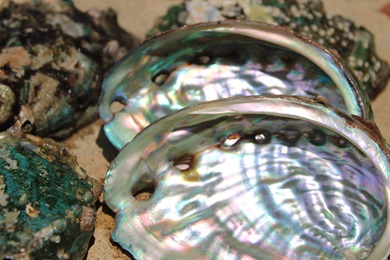This August, LET’S LEARN ABOUT…Mother-of-pearl!
Like real pearls, mother-of-pearl is an organic substance that comes from a living creature. You can find mother-of-pearl on the inside of the shells of molluscs like oysters, mussels, abalone, and snails!

Abalone shell
If you've seen the inside of a mollusc shell, you might have noticed that it's iridescent – with shimmery, rainbow-like colours that seem to change depending on what angle you look at it from. This iridescent quality of mother-of-pearl makes it a popular material for decorating furniture, jewellery, and other objects.
Harvesting mother-of-pearl is no easy task, though. Because mollusc shells are so brittle, great skill is needed to select, cut, and polish mother-of-pearl pieces into desired shapes.
Have a look at the following mother-of-pearl objects in the ACM collection and discover how the material has been used for decoration by different cultures in Asia. Then, take some time to marvel at the talent and skill of the craftsmen who made these pieces!